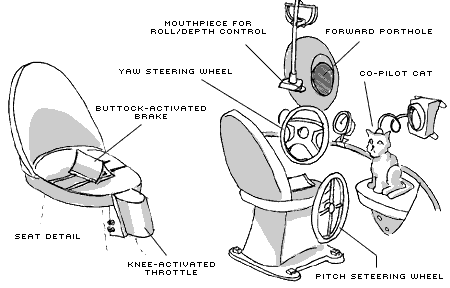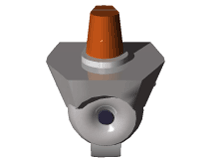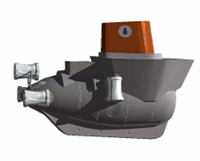 |
 |
|
|
 |
| by Jason Torchinsky |
| DISCLAIMER: I HAVE ABSOLUTELY NO IDEA HOW TO PILOT A SUBMERSIBLE-TYPE DEEP SEA SUBMARINE. I HAVE NEVER BEEN IN ONE, OR EVEN SEEN ONE UP CLOSE. I HAVE NEVER PILOTED ANY UNDERSEA WATERCRAFT, THOUGH I CAN DRIVE A STICK SHIFT. THEREFORE, WHEN USING THIS MANUAL TO PILOT A SUBMERSIBLE, PLEASE EXCERCISE CAUTION AND MAYBE TRY NOT TO BE TOO DRUNK. |
I'd be willing to bet that piloting a deep-sea submersible is one of the most rewarding things a deep-sea submersible owner can do. However, if you're like most of us, not only do you not have a deep-sea submersible, you wouldn't even know how to pilot one if you did. Well, ocean lovers, fret no more, because I have taken it upon myself to make a series of guesses about how I bet you drive one of these things, based on pictures I saw on the web, experiments I performed in my bathtub, and a fertile imagination. So, if you ever buy or inherit or find or steal a deep-sea submersible, make sure you read this manual fully before venturing out into the deep in search of lost treasure and hot mermaid tail.
First off, let's see what I guess the controls are like inside one of these things: |
 |
| One important thing to remember is that unlike driving a car, which can only go forward and left, a submersible can go in all directions: forward, back, left, right, up, and down, like a motorcycle. So, you need to have controls for all these types of motion. The left-right type of motion is called yaw and is controlled by the auto-type steering wheel in front of the main porthole. There is another motion, called pitch which is the tilt of the craft, as though pivoting around its center. This is controlled by the vertical wheel alongside the pilot's seat. Here's a simulator you can use to aquaint yourself with yaw and pitch: |
YAW

|
PITCH

|
|
Forward motion is controlled with by the throttle, which is controlled by squeezing the throttle oblong between your knees. Braking, which is actualy applying reverse thrust to slow down the submersible, is controlled by the buttock wedge which slides comfortably 'twixt your buttocks. (This is also why piloting a submersible is a pantsless affair.) The reasoning behind this is quite sound-- when people are in a potentialy dangerous situation, they often involuntarily clench their buttocks. Here, that instinctive motion is used to provide safe braking for the craft, possibly saving it from a collision. This control should be wiped clean with a damp cloth between uses.
Roll of the craft along its long axis and the rise and descent of the sub are controlled with the same mechanism: the mouthpiece. Biting down on the mouthpiece (another often involuntary act) raises the sub towards the saftey of the suface. Less pressure allows more descent. With the mouthpiece in place, tilting the head side-to-side controls the roll of the craft.
The most important piece of safety equipment on board is the co-pilot cat. This conventional domestic cat, with a small sensor attached to its head to read neurochemical stress levels, is used to determine when a potential hull rupture or similar undersea situation is near. Thanks to the cat's natural aversion to being wet and an innate urge to eat fish, a cat's brain can be read to check for elevated stress levels in the event of water intrusion or elevated aderenalin in the case of fish school proximity. These readings are displayed on a CRT above the cat's seat. No sub should be without one.
I hope this brief guide proves helpful. Also, if anyone actually has a chance to pilot a sub, I'd appreciate it if you'd let me know just how accurate my guesses are. I'm guessing pretty dead-on.
|
|
 |
 |